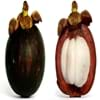Health Benefits
Good for diabetics, Improves well-being, Miraculin/miracle fruit makes sour things taste sweet
Asthma treatment, Bronchitis treatment, Cancer prevention, Heart care, Increases metabolic rate
General Benefits
Has taste modifying effect
Anti-inflammatory properties, Controls blood pressure, Digestive aid, Eye care, Healing of wounds, Maintains healthy cholesterol level, Strengthens bones, Treatment of sinusitis, Treatment of common cold
Skin Benefits
NA
Anti-aging benefits, Brightens and lightens complexion, Skin cleansing, Treatment of acne, Treatment of dark spots
Hair Benefits
NA
Prevents hair loss
Allergy Symptoms
Itching, Skin rash
Abdominal pains, Itching in tongue and other parts of mouth, Sneezing, Swelling, Tingling sensation in wrist and face, Vomiting, Wheezing
Side Effects
Changes taste of food eaten after this fruit, Coagulation
Causes swollen mouth, Allergic reaction, Diarrhoea, Nausea, Skin rash, Vomiting
Best Time to Eat
As a snack in the late afternoon, Eat the fresh ones, avoid mixing with any other foods, don't eat after meal., Morning time (before lunch)
Best if taken as a breakfast (or empty stomach), As a snack in the late afternoon, Eat the fresh ones, avoid mixing with any other foods, don't eat after meal., Morning time (before lunch)
Protein to Carb Ratio
Not Available
Vitamin A (Retinol)
Not Available
Vitamin B1 (Thiamin)
Not Available
Vitamin B2 (Riboflavin)
Not Available
Vitamin B3 (Niacin)
Not Available
Vitamin B5 (Pantothenic Acid)
Not Available
Vitamin B6 (Pyridoxin)
Not Available
Vitamin B9 (Folic acid)
Not Available
Vitamin C (Ascorbic Acid)
Vitamin K (Phyllochinone)
Not Available
Lutein+Zeaxanthin
Not Available
Phytosterol
Not Available
Water Content
Not Available
Calories in Fresh Fruit with Peel
Not Available
Not Available
Calories in Fresh Fruit without Peel
Not Available
Calories in Frozen Form
Not Available
Calories in Dried Form
Not Available
Calories in Canned Form
Not Available
Calories in Juice
Not Available
Calories in Jam
Not Available
Calories in Pie
Not Available
Type
Berry
Berry, Tropical
Varieties
Gymnema Sylvestre and Thaumatococcus Daniellii
Smooth Cayenne, Abacaxi, Red Spanish and Queen
Inside Color
Greyish-white
Yellow
Taste
NA, Sweet
Strong, Sweet, Tart
Origin
West Africa
Central America, South America
Grows on
Trees
Not Available
Soil Type
Well-drained
Clay, Sandy loam, Well-drained
Climatic Conditions
Rainfall
Hot, Sunny
Facts about
- The name 'Miracle' because of the magical experience you get after eating it.
- When you have lemon after eating this fruit, it tastes sweet as if it is added with sugar.
- It is also used as natural sweetener.
- A single pineapple takes 3 years to reach maturation.
- Pineapple is not an apple, but is actually a berry.
- The name is with reference to its resemblance to pine cones.
- Pineapple is sweeter if scales are more.
Top Producer
NA
Costa Rica
Other Countries
NA
Brazil, India, Philippines, Thailand
Top Importer
Not Available
United States of America
Top Exporter
United States of America
Costa Rica
Botanical Name
Synsepalum Dulcificum
Ananas comosus
Synonym
Miracle Berry, Miraculous Berry and Sweet Berry
Ananas sativus
Subkingdom
Tracheobionta
Tracheobionta
Division
NA
Magnoliophyta
Subclass
Asteridae
Commelinidae
Family
Sapotaceae
Bromeliaceae
Species
S. dulcificum
A. comosus
Generic Group
Not Available
Pineapple
Difference Between Miracle fruit and Pineapple
We might think that Miracle fruit and Pineapple are similar with respect to nutritional value and health benefits. But the nutrient content of both fruits is different. Miracle fruit and Pineapple Facts such as their taste, shape, color, and size are also distinct. The difference between Miracle fruit and Pineapple is explained here.
The amount of calories in 100 gm of fresh Miracle fruit and Pineapple with peel is Not Available and Not Available and the amount of calories without peel is Not Available and 50.00 kcal respectively. Thus, Miracle fruit and Pineapple belong to Low Calorie Fruits and Low Calorie Fruits category.These fruits might or might not differ with respect to their scientific classification. The order of Miracle fruit and Pineapple is Ericales and Poales respectively. Miracle fruit belongs to Sapotaceae family and Pineapple belongs to Bromeliaceae family. Miracle fruit belongs to Synsepalum genus of S. dulcificum species and Pineapple belongs to Ananas genus of A. comosus species. Beings plants, both fruits belong to Plantae Kingdom.









